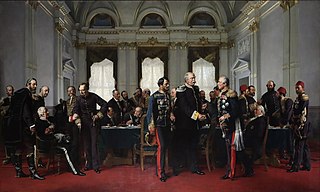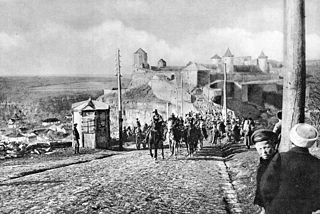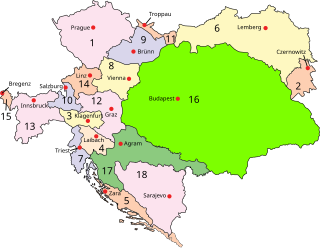Related Research Articles

Austria-Hungary, also referred to as the Austro-Hungarian Empire, the Dual Monarchy or the Habsburg Monarchy, was a multi-national constitutional monarchy in Central Europe between 1867 and 1918. A military and diplomatic alliance, it consisted of two sovereign states with a single monarch who was titled both Emperor of Austria and King of Hungary. Austria-Hungary constituted the last phase in the constitutional evolution of the Habsburg monarchy: it was formed with the Austro-Hungarian Compromise of 1867 in the aftermath of the Austro-Prussian War, following wars of independence by Hungary in opposition to Habsburg rule. It was dissolved shortly after Hungary terminated the union with Austria in 1918.

The Central Powers, also known as the Central Empires, were one of the two main coalitions that fought in World War I (1914–1918). It consisted of the German Empire, Austria-Hungary, the Ottoman Empire, and Bulgaria; this was also known as the Quadruple Alliance.

The Treaty of Brest-Litovsk was a separate peace treaty signed on 3 March 1918 between Soviet Russia and the Central Powers, by which Russia withdrew from World War I. The treaty, which followed months of negotiations after the armistice on the Eastern Front in December 1917, was signed at Brest-Litovsk.

The Treaty of Berlin was signed on 13 July 1878. In the aftermath of the Russian victory against the Ottoman Empire in the Russo-Turkish War of 1877–1878, the major powers restructured the map of the Balkan region. They reversed some of the extreme gains claimed by Russia in the preliminary Treaty of San Stefano, but the Ottomans lost their major holdings in Europe. It was one of three major peace agreements in the period after the 1815 Congress of Vienna. It was the final act of the Congress of Berlin and included the United Kingdom, Austria-Hungary, France, Germany, Italy, Russia and the Ottoman Empire. Chancellor of Germany Otto von Bismarck was the chairman and dominant personality.

The Congress of Berlin was a diplomatic conference to reorganise the states in the Balkan Peninsula after the Russo-Turkish War of 1877–1878, which had been won by Russia against the Ottoman Empire. Represented at the meeting were Europe's then six great powers: Russia, Great Britain, France, Austria-Hungary, Italy, and Germany; the Ottomans; and four Balkan states: Greece, Serbia, Romania and Montenegro. The congress concluded with the signing of the Treaty of Berlin, replacing the preliminary Treaty of San Stefano which had been signed three months earlier.

The Eastern Front or Eastern Theater, of World War I, was a theater of operations that encompassed at its greatest extent the entire frontier between Russia and Romania on one side and Austria-Hungary, Bulgaria, the Ottoman Empire, and Germany on the other. It ranged from the Baltic Sea in the north to the Black Sea in the south, involved most of Eastern Europe, and stretched deep into Central Europe. The term contrasts with the Western Front, which was being fought in Belgium and France. Unlike the static warfare on the Western Front, the fighting on the geographically larger Eastern Front was more dynamic, often involving the flanking and encirclement of entire formations, and resulted in over 100,000 square miles of territory becoming occupied by a foreign power.

The Treaty of Bucharest (1918) was a peace treaty between Romania and the opposing Central Powers following the stalemate reached after the campaign of 1917. This left Romania isolated after Russia's unilateral exit from World War I.

The Bosnian Crisis, also known as the Annexation Crisis or the First Balkan Crisis, erupted on 5 October 1908 when Austria-Hungary announced the annexation of Bosnia and Herzegovina, territories formerly within the sovereignty of the Ottoman Empire but under Austro-Hungarian administration since 1878.

The Treaty of Brest-Litovsk was signed on 9 February 1918 between the Ukrainian People's Republic (UPR) and the Central Powers, ending Ukraine's involvement in World War I and recognizing the UPR's sovereignty. The treaty, which followed the armistice on the Eastern Front in December 1917, was signed at Brest-Litovsk. The peace delegation from Soviet Russia, led by Leon Trotsky, did not recognize the UPR delegation, which had been sent from the Central Rada in Kiev, instead recognizing a delegation from the Ukrainian People's Republic of Soviets in Kharkov.
The U.S.–Austrian Peace Treaty is a peace treaty between the United States and Austria, signed in Vienna on August 24, 1921, in the aftermath of the First World War. This separate peace treaty was required because the United States Senate refused to advise and consent to the ratification of the multilateral Treaty of Saint-Germain-en-Laye of 1919.

The Operation Faustschlag or Unternehmen Faustschlag, also known as the Eleven Days' War, was a Central Powers offensive in World War I. It was the last major offensive on the Eastern Front.

The revolutions of 1917–1923 were a revolutionary wave that included political unrest and armed revolts around the world inspired by the success of the Russian Revolution and the disorder created by the aftermath of World War I. The uprisings were mainly socialist or anti-colonial in nature. Most socialist revolts failed to create lasting socialist states. The revolutions had lasting effects in shaping the future European political landscape, with, for example, the collapse of the German Empire and the dissolution of Austria-Hungary.

The Armistice of Focșani was an agreement that ended the hostilities between Romania and the Central Powers in World War I. It was signed on 9 December 1917 in Focșani in Romania.

The Ukrainian People's Republic (UPR) was a short-lived state in Eastern Europe. Prior to its proclamation, the Central Council of Ukraine was elected in March 1917 as a result of the February Revolution, and in June, it declared Ukrainian autonomy within Russia. Its autonomy was later recognized by the Russian Provisional Government. Following the October Revolution, the Central Council of Ukraine denounced the Bolshevik seizure of power and proclaimed the Ukrainian People's Republic with a territory including the area of approximately eight Russian imperial governorates. It formally declared its independence from Russia on 22 January 1918.

On 15 December [O.S. 2 December] 1917, an armistice was signed between the Russian Republic led by the Bolsheviks on the one side, and the Austro-Hungarian Empire, the Kingdom of Bulgaria, the German Empire and the Ottoman Empire—the Central Powers—on the other. The armistice took effect two days later, on 17 December [O.S. 4 December]. By this agreement, Russia de facto exited World War I, although fighting would briefly resume before the Treaty of Brest-Litovsk was signed on 3 March 1918, and Russia made peace.

The dissolution of Austria-Hungary was a major political event that occurred as a result of the growth of internal social contradictions and the separation of different parts of Austria-Hungary. The more immediate reasons for the collapse of the state were World War I, the 1918 crop failure, general starvation and the economic crisis. The Austro-Hungarian Empire had additionally been weakened over time by a widening gap between Hungarian and Austrian interests. Furthermore, a history of chronic overcommitment rooted in the 1815 Congress of Vienna in which Metternich pledged Austria to fulfill a role that necessitated unwavering Austrian strength and resulted in overextension. Upon this weakened foundation, additional stressors during World War I catalyzed the collapse of the empire. The 1917 October Revolution and the Wilsonian peace pronouncements from January 1918 onward encouraged socialism on the one hand, and nationalism on the other, or alternatively a combination of both tendencies, among all peoples of the Habsburg monarchy.

The Austro-Hungarian strike of January 1918 was a strike which spread across Austria-Hungary between January 3 and 25, 1918 demanding better living and working conditions and an end to World War I. It is known as the "Jännerstreik" as opposed to the "Januarstreik" – a similar strike movement which lasted from 25 January to 1 February 1918 in Germany – Jänner being the usual spelling for January in Austria.
The Treaty of Peace between Finland and Germany, also called the Berlin Peace Treaty, signed in Berlin on 7 March 1918 ended the state of war that existed between Finland and the German Empire as a result of World War I. It paved the way for German intervention in the Finnish Civil War and the invasion of Åland.

Central Powers intervention in the Russian Civil War consisted of a series of multi-national military expeditions starting in 1918. This intervention was picking up from the Eastern Front against the newly set up Russian Republic. The main goals of the intervention were to maintain the territories received in the Treaty of Brest-Litovsk, prevent a re-establishment of the Eastern Front, and administer new conquered territories. After the defeat of the Central Powers, many armies that stayed mostly helped the Russian White Guard eradicate communists in the Baltics until their eventual withdrawal and defeat. In addition, pro-German factions fought against the newly independent Baltic states until their defeat by the Baltic States, backed by the victorious Allies.
References
- 1 2 3 4 Randall Lesaffer and Mieke van der Linden, "Peace Treaties after World War I", in Frauke Lachenmann and Rudiger Wolfrum (eds.), The Law of Armed Conflict and the Use of Force: Articles from The Max Planck Encyclopedia of Public International Law (Oxford University Press, 2017), pp. 910–919, at 911.
- 1 2 3 4 5 Stephan Verosta, "Peace treaties after World War I", in Rudolf Bernhardt (ed.), Encyclopedia of Public International Law 4: Use of Force – War and Neutrality – Peace Treaties (N–Z) (North Holland, 1982), pp. 110–117, at 112.
- ↑ Jaakko Uotila, The Finnish Legal System (Suomen lakimiesliiton kustannus, 1966), p. 249.
- ↑ Treaty of Peace and Amity between Bulgaria and Finland, signed at Berlin, 21 May 1918, Oxford Historical Treaties, Oxford Public International Law.
- 1 2 3 4 Texts of the Finland "Peace": With Map (Washington, D.C.: Government Printing Office, 1918), pp. 47–48 (German text of treaty with English translation).
- ↑ Convention between Austria-Hungary and Finland concerning Certain Questions of Private Law supplementary to the Treaty of Peace, signed at Vienna, 29 May 1918, Oxford Historical Treaties, Oxford Public International Law.